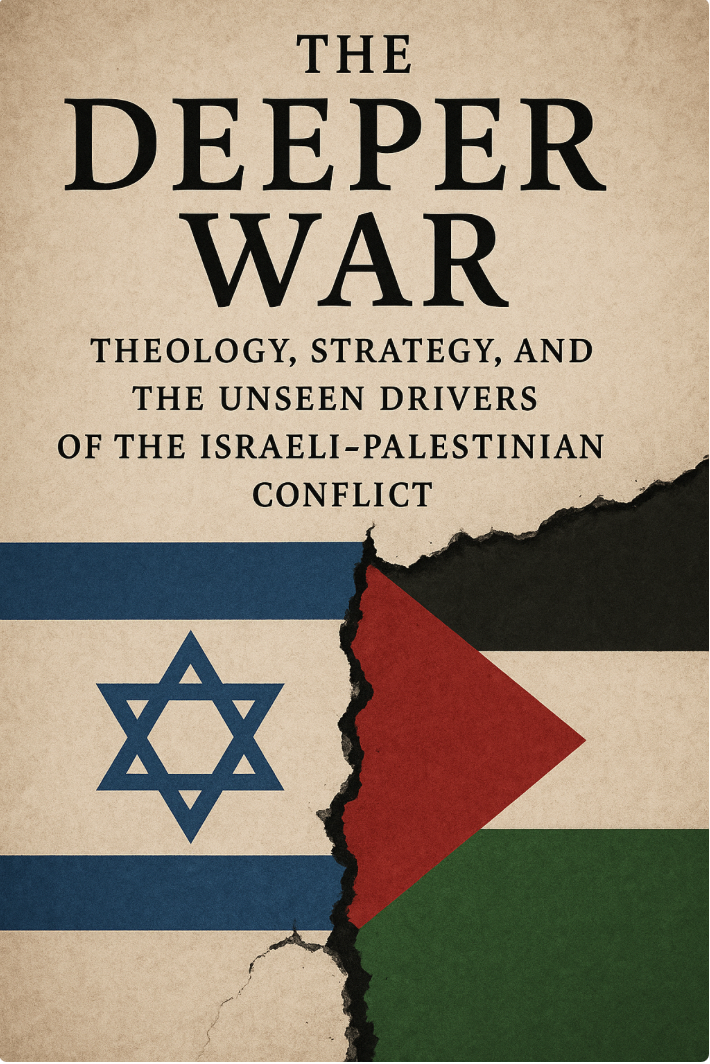

The Israeli-Palestinian conflict is often presented in diplomatic circles and media commentary as a territorial dispute, rooted in competing claims to land, sovereignty, and self-determination. While those elements are real, they do not fully explain the durability or the emotional intensity of the conflict. Beneath the politics lies a deeply embedded theological and ideological structure that informs how many actors, especially Islamists, perceive the land and their relationship to non-Muslims. This structure is not an invention of modern extremism but part of a worldview that predates the existence of the modern state of Israel. Until this underlying vision is acknowledged, efforts at negotiation will continue to fall short. To many in the West, peace means coexistence, compromise, and equal recognition. But for groups shaped by classical Islamic thought, peace may mean the restoration of religious supremacy and the reversal of what is seen as an illegitimate political reality. Understanding this divergence is essential if we are to move the conversation beyond platitudes and toward meaningful resolution.
The Sacred Geography of Dar al-Islam
Central to Islamic jurisprudence is a geographic and theological concept that divides the world into Dar al-Islam (House of Islam) and Dar al-Harb (House of War). According to this framework, any land once ruled by Islam remains sacred and must be returned to Muslim rule, regardless of how or when it was lost. This doctrine is drawn from classical legal texts and has informed Muslim governance and identity for centuries (Lewis, 1990). The existence of Israel, particularly on land that was under Islamic rule for centuries, is seen not merely as a political aberration but as a theological crisis. For those who embrace this worldview, the restoration of Muslim control is not negotiable but obligatory. This makes the Israeli-Palestinian conflict fundamentally different from secular nationalist struggles. Even full withdrawal from the West Bank or East Jerusalem would not satisfy such a vision. The issue is not the size of the Jewish state—it is its very existence.
The Historical Subjugation of Non-Muslims
This theological worldview has historically shaped how Muslim societies treated non-Muslim communities. Under Islamic rule, Jews and Christians were granted the status of dhimmis—protected but subordinate subjects. This status involved legal and social restrictions, including the payment of special taxes, bans on public religious expression, and exclusion from political and military roles. While the dhimmi system allowed for the presence of religious minorities, it was never based on equality (Stillman, 1979). In many cases, periods of relative peace were followed by episodes of violence and repression. This conditional tolerance was always at risk of collapse. The same theological hierarchy that kept Jews in a subordinate place under Muslim rule now fuels resentment toward Jewish sovereignty over Muslims. From this perspective, Zionism is not just nationalism—it is an inversion of the religious order, and thus, a provocation.
The Erasure of Indigenous Minorities
The experience of other indigenous groups in the Middle East reinforces this pattern of intolerance. The Copts in Egypt, once a majority, now live as a marginalized minority. Yazidis, Assyrians, Chaldeans, and Mandaeans have all faced persecution, displacement, or genocide. These communities were not destroyed by Western colonialism but by regimes and movements that sought religious and cultural homogeneity (Bat Ye’or, 1996). Islamic imperial structures absorbed or eliminated non-Muslim civilizations through force, taxation, legal exclusion, and social marginalization. These realities challenge the popular notion that Western imperialism is the sole source of injustice in the region. The disappearance of these ancient peoples shows that internal colonization was also a significant force in shaping the modern Middle East. The implication is that the treatment of Israel is not unique, but part of a broader historical pattern of hostility toward autonomous non-Muslim entities within what is seen as Islamic territory.
Hamas and the Strategy of Manufactured Suffering
Since seizing control of Gaza in 2007, Hamas has governed not only through violence but through a sophisticated media and psychological strategy. It embeds its fighters in civilian areas, stores weapons in hospitals and schools, and disguises combatants as non-combatants. The result is predictable and intentional—civilian deaths that fuel international outrage. According to Mosab Hassan Yousef, the son of a Hamas founder who later worked with Israeli intelligence, Hamas “uses the suffering of its people as a weapon” (NewsNation, 2025). He has personally witnessed Hamas fighters shooting at civilians who attempt to access aid, and he has observed the smuggling of weapons in humanitarian convoys. This is not simply collateral damage. It is a deliberate tactic. The more Gazans suffer, the more pressure is placed on Israel diplomatically. In this framework, human lives are not sacred. They are political tools.
Humanitarian Aid as Leverage
Calls for increased humanitarian aid to Gaza often ignore the complexity of aid distribution in a territory controlled by a terrorist organization. Israel inspects and approves thousands of aid trucks entering Gaza, but once they arrive, Hamas controls the supply chains. Civilians are routinely denied access unless they comply with Hamas directives. In some cases, Hamas has reportedly shot at civilians who collect aid outside of its channels (NewsNation, 2025). This is not merely inefficiency—it is weaponization. Humanitarian aid becomes a tool of control, reinforcing Hamas’s dominance and extending the conflict. While many in the West believe more aid will relieve suffering, the reality is that without structural change, aid can entrench the very regime causing the suffering. Compassion divorced from accountability is not justice—it is complicity.
The Myth of Hamas as a Fringe Movement
Western commentators often claim that Hamas does not represent the Palestinian people. However, recent polling paints a more sobering picture. A 2024 survey found that 50 percent of Palestinians supported Hamas’s decision to launch the October 7 attacks, while 87 percent denied that atrocities committed during those attacks ever occurred (Palestinian Center for Policy and Survey Research, 2024; J-TV, 2025). These are not fringe beliefs. They indicate a cultural and ideological environment in which terrorism is not universally condemned, but often glorified. This is not just a Hamas problem—it is a societal crisis. Years of propaganda, religious indoctrination, and antisemitic messaging have shaped generations. The result is a public that too often rewards violence and denies responsibility. Until this cultural infrastructure is addressed, no diplomatic agreement will bring lasting peace.
Antisemitism Before Zionism
The claim that antisemitism in the Arab world is a modern response to Zionism is historically inaccurate. Pogroms and massacres occurred long before the establishment of Israel. In 1834, Arab mobs attacked and murdered Jews in Sfat. In 1929, the Jewish community of Hebron was nearly annihilated in a brutal massacre. These events were not caused by Israeli policy—they were the result of deep-seated religious and cultural hostility. A recent documentary by JTV Plus highlights this forgotten history, showing that antisemitism in the region long preceded the state of Israel (Stillman, 1979). Recognizing this history is essential. It shifts the narrative from one in which Israel is the instigator to one in which Israel is the most recent target of an older and wider pattern of hatred.
Toward a More Honest Conversation
If peace is to be achieved, it must be built on truth. The Israeli-Palestinian conflict is not simply about borders or settlements. It is about competing civilizational visions, one of which continues to sanctify violence against non-Muslims who defy its religious order. The international community must stop pretending that Hamas is a rational political actor or that humanitarian aid alone will resolve a crisis rooted in theology and ideology. It must also stop treating Israel’s restraint as aggression and Gaza’s suffering as an accident. Compassion must be coupled with clarity. Anything less ensures that this conflict will not end, but simply repeat itself under different banners.
References
Bat Ye’or. (1996). The decline of Eastern Christianity under Islam: From jihad to dhimmitude. Fairleigh Dickinson University Press.
J-TV. (2025, August 4). New poll reveals what Palestinians really think of Hamas today – and it’s chilling [Video]. YouTube. https://www.youtube.com/watch?v=IuCvGukd2wA
Lewis, B. (1990). The political language of Islam. University of Chicago Press.
NewsNation. (2025, August 1). Israel doing everything to limit Gaza civilian casualties: Son of Hamas' founder | CUOMO [Video]. YouTube. https://www.youtube.com/watch?v=ZDXz5kKt27Y
Palestinian Center for Policy and Survey Research. (2024). Public Opinion Poll No. 89.
Pew Research Center. (2017). Israel’s religiously divided society. https://www.pewresearch.org/religion/2016/03/08/israels-religiously-divided-society/
Stillman, N. A. (1979). The Jews of Arab lands: A history and source book. Jewish Publication Society.
Who is Dr. Tim Orr?
Tim serves full-time with Crescent Project as the assistant director of the internship program and area coordinator, where he is also deeply involved in outreach across the UK. A scholar of Islam, Evangelical minister, conference speaker, and interfaith consultant, Tim brings over 30 years of experience in cross-cultural ministry. He holds six academic degrees, including a Doctor of Ministry from Liberty University and a Master’s in Islamic Studies from the Islamic College in London.
In addition to his ministry work, Tim is a research associate with the Congregations and Polarization Project at the Center for the Study of Religion and American Culture at Indiana University Indianapolis. His research interests include Islamic antisemitism, American Evangelicalism, and Islamic feminism. He has spoken at leading universities and mosques throughout the UK, including Oxford University, Imperial College London, and the University of Tehran. He has published in peer-reviewed Islamic academic journals. Tim is also the author of four books.
